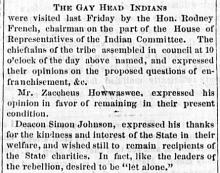The work of dredging now going on at Tashmoo Creek focuses attention upon one of the historical landmarks of the Island and one of which very little is remembered or preserved. Indians called this locality Chappaquansett, and old records refer to the creek as Chappaquansett Creek, rather than Tashmoo. It is evident that the Indians frequented this place in the olden days, as sizable middens have been located nearby and others are presumably buried beneath the shifting sands or have been washed out to sea. It is significant, in the light of present day claims, that scallop and oyster shells are to be found in these middens showing that, at some time or other, these shellfish grew and bred in Lake Tashmoo. Significant, too, was the discovery, a few years ago, of a cache of Indian weapons, eleven tomahawks, all buried in one spot not far from the creek. Why they were concealed in this manner is one of those inexplicable things. Of beautiful design and workmanship, they were the finest examples of rough stone implements belonging to Vineyard Indians.
More curious, was the discovery with them, of an amulet or collar ornament. This was extraordinary, both as to material and design, while the workmanship was far superior to that generally found in rough stone workmanship. The stone resembled the soapstone of China, and consisted of a thin, regularly-cut slab, about three and one-half inches long and half that in width. On it was carved in relief, a twig, with leaves and fruit upon it, resembling a spray of wild cherry or some variety of huckleberry. A hole had been drilled through one end of the stone by which it could be attached to a necklace.
Sought Shelter in Lake
Through this creek, if tradition can be credited, the blockade-runners of the Revolution, sailed or rowed their fishing boats, seeking the shelter of Lake Tashmoo, and likewise the deep water of the lake where, on occasion, they were forced to sink their boats in order to prevent their destruction.
In later years, men and boys congregated along the creek when the alewives ran, dipping and seining the fish by the hundreds of barrels. The herring fishery was valuable in those times, and although there has been but little commercial fishing there in many years, the rights of t eh inhabitants of Tisbury to fish this creek have been preserved.
It is interesting to note that throughout the years that men have caught alewives in Tashmoo or Chappaquansett Creek, the favored implement used is the one which the white men borrowed from the Indians, a dip-net, with a curiously-curved, wooden bow. Many of these old nets are to be found in Vineyard Haven shops and sheds, their age unknown, but still sound and suitable for use, while the style and design make them most practical for such work.









Comments